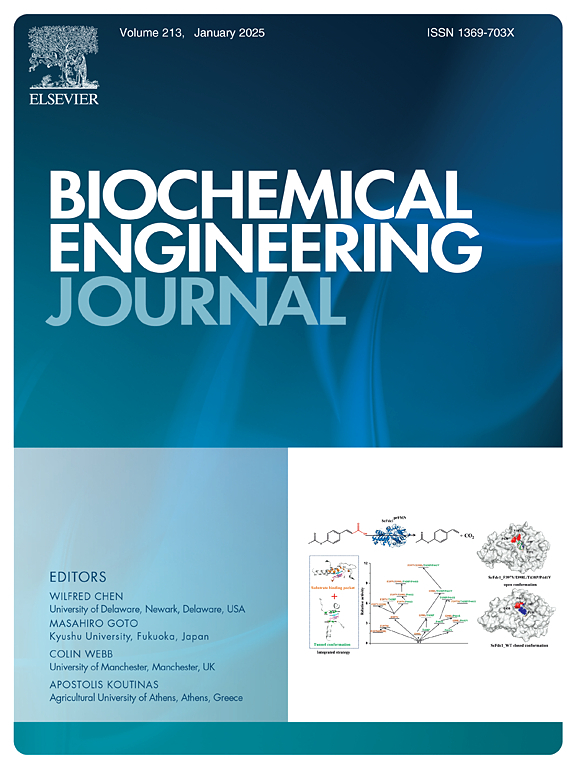Developing an off-site bicarbonation absorber system to promote microalgal fixation of CO2 in exhaust gas from biogas upgrading
IF 3.7
3区 生物学
Q2 BIOTECHNOLOGY & APPLIED MICROBIOLOGY
引用次数: 0
Abstract
In order to address the risk of explosion due to CH4 from exhaust gas produced during biogas upgrading in closed carbon fixation systems employing photosynthetic microalgae, an off-site bicarbonation absorber system was developed to promote microalgal CO2 fixation under atmospheric pressure. The abundant CO2 in the biogas upgrading exhaust gas (≥90 vol% CO2, ≤10 vol% CH4) reacted with a Na2CO3 solution in the off-site bicarbonation absorber to produce NaHCO3, which was used as carbon source for microalgal growth in enclosed column photobioreactors. After the reaction, CH4 was discharged outside the bicarbonation absorber because it did not react with the Na2CO3 solution and was extremely difficult to dissolve in water, thereby avoiding the explosion risk due to accumulated CH4 in the enclosed column photobioreactors. The experimental results showed that the Spirulina growth rate first increased 1.7 times, peaking at 0.6 g/L/d, and then decreased when the bicarbonation reaction time (optimal 50 min), absorber diameter (optimal 10 cm), initial Na2CO3 concentration (optimal 173 mM), and exhaust gas aeration rate (optimal 100 sccm) increased. The optimal molar ratio of NaHCO3 to total inorganic carbon in the bicarbonation absorber solution reached 79 %. The sufficient HCO3- supply and suitable pH of the microalgal solution improved the synthesis of photosynthetic pigments in the microalgal cells and enhanced their photochemical efficiency and carbon sequestration rates.
开发异地碳酸氢盐吸收系统,促进微藻固定沼气提纯废气中的二氧化碳
为了解决采用光合作用微藻的封闭式碳固定系统在沼气升级过程中产生的废气中的 CH4 导致爆炸的风险,开发了一种异地碳酸氢盐吸收系统,以促进微藻在大气压力下固定 CO2。沼气提纯废气中丰富的 CO2(≥90 vol% CO2,≤10 vol% CH4)与异位重碳酸盐吸收器中的 Na2CO3 溶液反应生成 NaHCO3,NaHCO3 用作封闭柱状光生物反应器中微藻生长的碳源。反应结束后,由于 CH4 不会与 Na2CO3 溶液发生反应,且极难溶解于水,因此 CH4 被排放到了碳酸氢盐吸收器之外,从而避免了封闭式柱状光生物反应器中累积的 CH4 所带来的爆炸风险。实验结果表明,当重碳酸化反应时间(最佳值为 50 分钟)、吸收器直径(最佳值为 10 厘米)、初始 Na2CO3 浓度(最佳值为 173 mM)和废气通气速率(最佳值为 100 sccm)增加时,螺旋藻的生长速率先增加 1.7 倍,达到 0.6 g/L/d 的峰值,然后下降。双碳酸化吸收器溶液中 NaHCO3 与总无机碳的最佳摩尔比达到 79%。微藻溶液中充足的 HCO3- 供应和适宜的 pH 值改善了微藻细胞中光合色素的合成,提高了其光化学效率和固碳率。
本文章由计算机程序翻译,如有差异,请以英文原文为准。
求助全文
约1分钟内获得全文
求助全文
来源期刊

Biochemical Engineering Journal
工程技术-工程:化工
CiteScore
7.10
自引率
5.10%
发文量
380
审稿时长
34 days
期刊介绍:
The Biochemical Engineering Journal aims to promote progress in the crucial chemical engineering aspects of the development of biological processes associated with everything from raw materials preparation to product recovery relevant to industries as diverse as medical/healthcare, industrial biotechnology, and environmental biotechnology.
The Journal welcomes full length original research papers, short communications, and review papers* in the following research fields:
Biocatalysis (enzyme or microbial) and biotransformations, including immobilized biocatalyst preparation and kinetics
Biosensors and Biodevices including biofabrication and novel fuel cell development
Bioseparations including scale-up and protein refolding/renaturation
Environmental Bioengineering including bioconversion, bioremediation, and microbial fuel cells
Bioreactor Systems including characterization, optimization and scale-up
Bioresources and Biorefinery Engineering including biomass conversion, biofuels, bioenergy, and optimization
Industrial Biotechnology including specialty chemicals, platform chemicals and neutraceuticals
Biomaterials and Tissue Engineering including bioartificial organs, cell encapsulation, and controlled release
Cell Culture Engineering (plant, animal or insect cells) including viral vectors, monoclonal antibodies, recombinant proteins, vaccines, and secondary metabolites
Cell Therapies and Stem Cells including pluripotent, mesenchymal and hematopoietic stem cells; immunotherapies; tissue-specific differentiation; and cryopreservation
Metabolic Engineering, Systems and Synthetic Biology including OMICS, bioinformatics, in silico biology, and metabolic flux analysis
Protein Engineering including enzyme engineering and directed evolution.
 求助内容:
求助内容: 应助结果提醒方式:
应助结果提醒方式:


